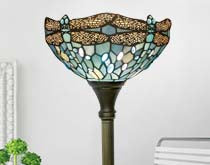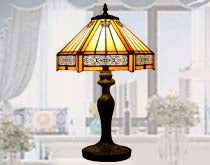How to make a lampshade
Welcome to the world of lampshade crafting, where you hold the power to transform a simple lamp into a work of art that illuminates your space with your personal touch. We appreciate your visit and are thrilled to guide you through a creative journey from start to finish, unveiling the secrets of crafting beautiful lampshades. So, let's dive in and brighten up your world with the warmth and charm of your own handmade lampshade.
For example, stained glass lamp shades - Tiffany Lamp.
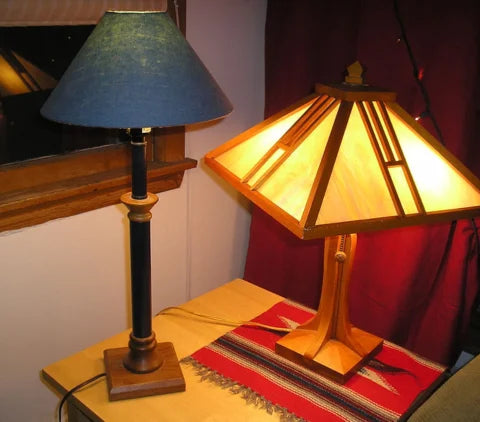
How to Create Your Lampshade from Scratch
Creating a lampshade from scratch is a delightful DIY project that allows you to infuse your living space with your unique style and creativity. This section will walk you through crafting your lampshade, covering essential steps and materials. Let's dive into the art of making a lampshade.
1. Gather Your Materials
To embark on your lampshade crafting adventure, you'll need key materials, including a frame, fabric, adhesive, and basic crafting tools. The lampshade frame sets the foundation for your project, so choose one that suits your lamp's style and size. Whether it's a classic drum shape, an elegant empire style, or any other design, selecting the right frame is a crucial starting point.
2. Select the Right Fabric
The fabric you choose for your lampshade will play a significant role in its final appearance. Your choice can be influenced by the room's décor, your personal style, and the ambiance you want to create. Consider whether you prefer a traditional, modern, or whimsical look. Fabrics come in various textures and patterns, from solid colors to intricate designs, and this diversity allows you to be as creative as you desire.
3. Take Accurate Measurements and Cutting
Accurate measurements are the key to creating a lampshade that fits perfectly. Begin by measuring the height and circumference of the frame. Correctly measuring the frame is essential to ensure a seamless fit. Once you've recorded your measurements, carefully cut the fabric to match them. Precision is the key here, as a well-measured fabric ensures a smooth, wrinkle-free finish.
4. Apply Adhesive
With your fabric cut to size, it's time to apply adhesive and attach it to the frame. High-quality fabric glue is an excellent choice for this task. Begin by applying adhesive evenly to the frame. Work gently to ensure an even distribution of glue. As you attach the fabric, smooth it carefully, avoiding wrinkles or bubbles. Patience and precision are essential in this process, but the effort is worthwhile.
5. Add Finishing Touches
You'll want to trim any excess material with the fabric securely attached. The goal is to achieve a clean and polished look. To ensure a neat finish, trim the fabric with sharp scissors, maintaining a consistent and even edge. The fabric that remains should align seamlessly with the frame.
Additionally, add decorative elements to personalize your lampshade further. This can include tassels, fringe, beads, or embellishments that align with your design vision. These finishing touches give your lampshade a unique, individualized look reflecting your style and creativity.
6. Customize To Your Taste
While the basic steps provide a structured approach to creating a lampshade, you can unleash your creativity. You can experiment with different fabric colors and patterns or even consider techniques like stenciling or hand-painting to add unique designs to your lampshade.
Crafting a lampshade from scratch lets you display your creativity and style, making it a rewarding and enjoyable DIY project.
By carefully selecting materials, measuring accurately, applying adhesive with precision, and adding finishing touches, you can craft a lampshade that provides illumination and adds a personalized and artistic touch to your living space. The process is fun and fulfilling, resulting in a functional work of art that brightens up your home.
Now, let's explore these steps in greater detail.
Lampshade Frames
Lampshades are not just accessories to your lighting fixtures; they are artistic expressions that illuminate your living spaces with warmth and personality. To begin crafting a lampshade, one must first understand the pivotal role that lampshade frames play in the process.
A lampshade frame is the essential skeleton of your lampshade, providing the structure and shape of the final creation. While often hidden beneath the fabric cover, it significantly impacts the lampshade's aesthetics and functionality. Lampshade frames are typically crafted from materials like metal, wire, or even plastic, each with unique characteristics.
Types of Lampshade Frames
Lampshade frames are the skeletal structure that holds your lampshade together. Lampshade frames come in various styles and shapes, allowing you to match them to your lamp and your interior design preferences. Common shapes include:
- Drum Frames: The classic drum shape is a timeless favorite. Its straightforward cylindrical design offers a clean, uncluttered look that suits various decors. Whether aiming for a modern or traditional appearance, the drum frame is versatile.
- Empire Frames: Empire frames are more tapered, with a smaller top and wider bottom. This design provides an elegant and regal appearance to the lampshade. It works particularly well with traditional or vintage-style lamps.
- Bell Frames: With a bell-like contour, these frames sport a gracefully flared base that gently scatters and softens the light. Bell frames add a touch of charm and warmth to your lighting and can be an excellent choice for cozy and inviting spaces.
- Square or Rectangular Frames: If you prefer a more modern and geometric design, square or rectangular frames are ideal. They provide a structured and contemporary look that complements modern decor and sleek lines.
- Oval Frames: Oval frames offer a unique twist to the lampshade's appearance. Their elongated shape provides an elegant and timeless quality that can elevate the aesthetics of your space.
Matching the Frame to Your Lamp
The choice of a lampshade frame is not arbitrary; it should harmonize with the lamp's design and size. The frame should be proportional to the lamp's base and height, ensuring it complements rather than overwhelms it.
For instance, a slender and tall lamp would pair well with a drum or empire frame to add balance. In contrast, a wider lamp base may benefit from a square or rectangular frame to maintain symmetry. Understanding how to match the lampshade frame to your lamp is essential for achieving a cohesive and visually pleasing result.
Crafting Your Unique Lampshade
Once you've selected the appropriate lampshade frame, you're ready to embark on the creative journey of crafting your unique lampshade. Whether using fabric, paper, or any other material for the lampshade cover, the frame is the anchor, ensuring the shade retains its intended shape.
As you embark on your crafting adventure, remember that the lampshade frame is not just a functional component; it's a canvas for your artistic expression. You have the freedom to experiment with different fabrics, colors, patterns, and textures to create a lampshade that reflects your personal style and enhances the ambiance of your space.
Choose a frame that complements your lamp's design and fits your crafting skill level. You can find these frames in various sizes, so measure your lamp's dimensions for a perfect fit.
Related reading: How to Size Lampshades for Tiffany Floor Lamps?
Types of Lampshades to Explore
When it comes to lampshades, the diversity in designs is truly remarkable. Choosing the right lampshade type can greatly influence the ambiance and style of a room. There are different types of lampshades, each with its unique charm:
1. Hardback Lampshades
These are known for their durability and rigidity. They are constructed with a sturdy frame covered in fabric. Hardback lampshades maintain their shape and provide a clean, classic appearance. They are ideal for spaces where a timeless and well-defined look is desired, such as formal living rooms or traditional office settings.
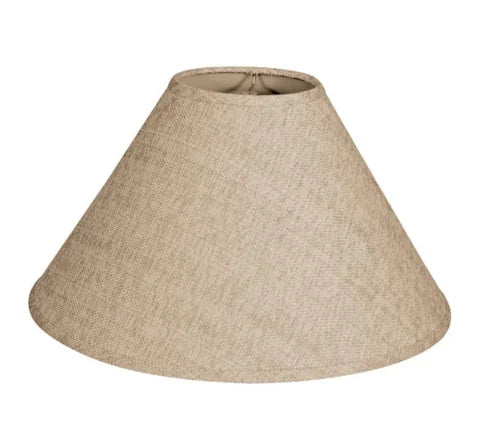
2. Softback Lampshades
Compared to hardback shades, softback lampshades have a fabric covering over a soft lining. This creates a more textured and cozy appearance. Softback shades offer a diffused, inviting glow in relaxed settings like bedrooms, cozy reading nooks, or informal family spaces.

3. Clip-On Lampshades
Clip-on lampshades are designed to attach to the light bulb directly. They are typically small and are ideal for small table lamps or wall sconces. These shades provide a minimalist, space-saving solution, perfect for areas with limited space or for achieving a sleek, uncluttered look.
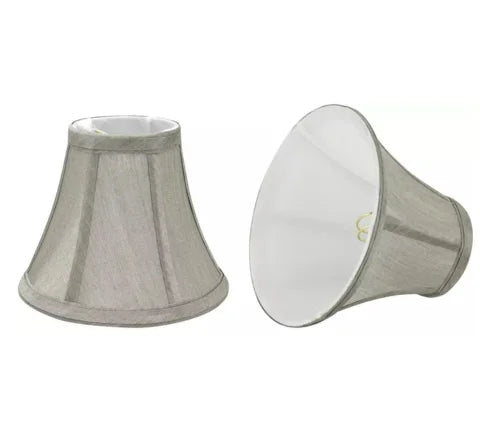
4. Uno-Fitter Lampshades
Uno-fitter lampshades feature a large, round, flat bottom that rests on the socket. They are well-suited for floor lamps and many large table lamps. Uno-fitter shades provide ample coverage and are available in various styles, making them versatile for decor themes.
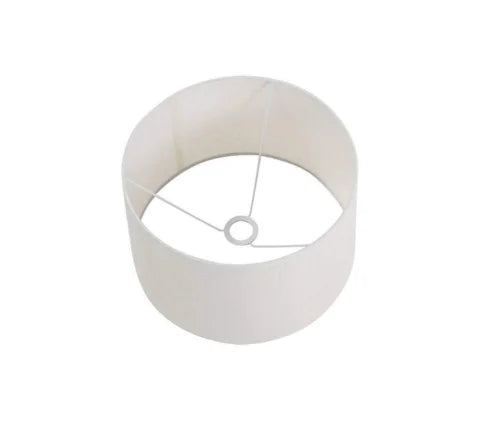
5. Spider Fitter Lampshades
Spider fitter lampshades are commonly used for floor and larger table lamps. They have a frame resembling a spider sitting on a harp. This design lets the lampshade sit securely above the light bulb and diffuse light beautifully. Spider fitter lampshades come in various shapes and materials, making them adaptable to different room aesthetics.
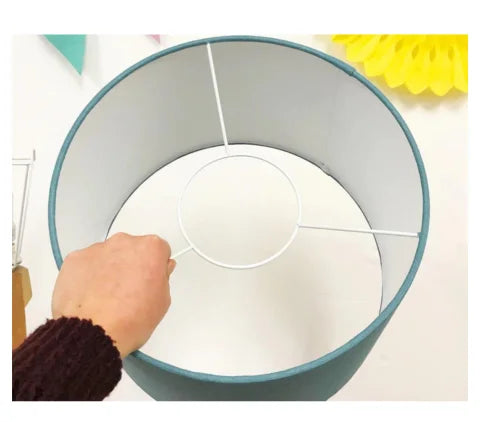
6. Empire Lampshades
Empire lampshades are characterized by their classic and elegant shape. They have a wider bottom and a smaller top, creating a timeless silhouette that complements a wide range of lamp styles. Empire shades are versatile and can be employed in traditional and modern settings.
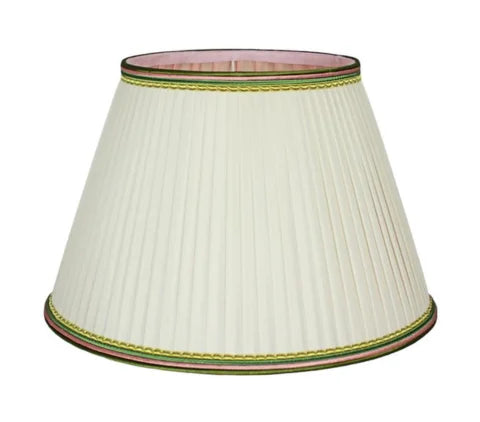
7. Drum Lampshades
Drum lampshades are cylindrical, with equal-sized top and bottom diameters. They offer a contemporary, clean look and are highly adaptable. Their sleek design works well with various decor styles and is particularly popular in modern interior settings.
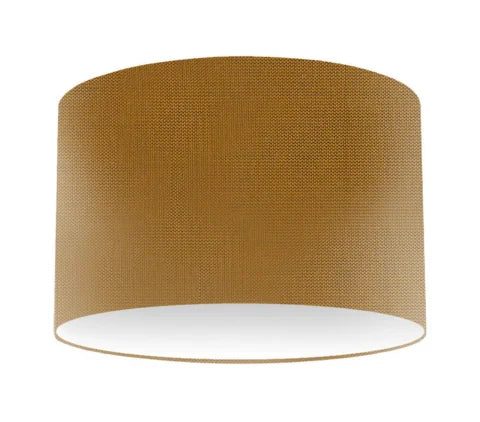
8. Bell Lampshades
Bell lampshades resemble the form of a bell, with a flared shape at the bottom. These shades create a classic, elegant look and are frequently used in more traditional decor schemes. Their charming, timeless design adds a touch of sophistication to spaces.

9. Square or Rectangular Lampshades
Square or rectangular lampshades bring a touch of geometric charm to a room. They are perfect for spaces with modern or minimalist decor, as they introduce clean lines and a sense of order. These shades provide a contemporary aesthetic and are excellent for desk lamps or pendant lighting.

10. Oval Lampshades
Oval lampshades offer a unique and elegant touch to your lamp. They bring a sense of softness and a departure from the more common circular shapes. Oval lampshades work well in spaces that embrace curves and offer a touch of refinement.
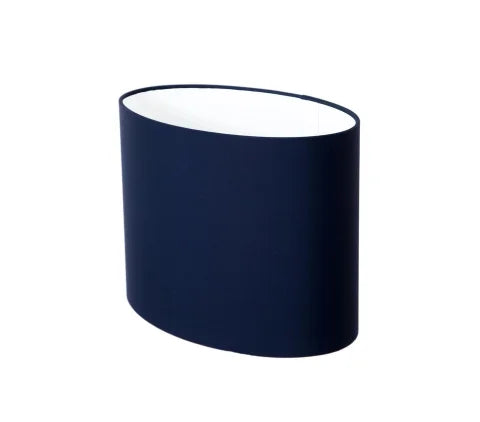
The diverse array of lampshade types allows you to tailor your lighting to suit the aesthetics and functionality of your space. By selecting the right lampshade type, you can elevate your interior design, create the desired lighting effects, and infuse your personal style into your home decor. Whether you prefer the timeless charm of an empire shade, the modern appeal of a drum shade, or the cozy ambiance of a softback shade, there's a lampshade type that perfectly complements your vision for each room in your home.
Types of Lampshade Covers
When crafting the perfect lampshade, choosing the fabric is pivotal in determining its final appearance. Your fabric selection can transform an ordinary lamp into a showpiece that complements your room's style and sets the ambiance. Here are some popular options:
1. Cotton
Cotton fabric is an ever-popular choice for lampshade covers due to its versatility. It comes in many patterns and colors, making it suitable for various design styles. Whether you're aiming for a contemporary, classic, or even a quirky look, cotton can adapt beautifully.
With cotton, you can experiment with vibrant prints, from floral motifs to geometric shapes. Its breathability and natural look add an inviting touch to your space, emitting a soft and cozy glow when the lamp is illuminated. Cotton lampshade covers are a fantastic choice for those who want to balance style and functionality.
2. Silk
Silk is synonymous with luxury and elegance. This is the fabric to consider if you want to create a luxury lampshade. Silk lampshade covers have a natural sheen that adds a touch of glamour to any room. The fabric's reflective qualities create a visual spectacle when the light shines through and infuses the space with a refined ambiance.
Silk is available in an array of colors and patterns. Solid silk lampshade covers showcase the fabric's luminous beauty. In contrast, patterned silks can lend a touch of the exotic or classic style. Silk lampshades are a top choice for formal and upscale settings, and they can instantly elevate the overall look of a room.
3. Linen
Linen lampshade covers are excellent for those who appreciate a more relaxed and textured look. Linen brings a casual yet elegant atmosphere to your decor. Its natural, earthy appearance pairs well with various interior styles, from rustic to contemporary.
Linen lampshade covers are often favored for their neutral, earth-toned colors that seamlessly blend with a room's design. They create a warm and cozy ambiance when the lamp is lit. Linen's unique texture adds depth to your space, making it a fantastic choice for those who value simplicity with a hint of sophistication.
4. Paper
If you want to make a bold design statement, paper lampshade covers are worth considering. These lampshades offer a modern and distinct look, setting them apart from more conventional fabric options. Paper covers are available in various finishes, from smooth and glossy to textured and artistic.
The paper's translucence creates a soft, diffused lighting effect when the lamp is switched on. It's an ideal choice for contemporary or minimalist interiors. Paper lampshade covers can be an excellent choice for homes with a penchant for unique and artistic lighting solutions.
5. Mix and Match
Feel free to use more than one fabric type when crafting your lampshade. Mixing and matching fabrics can create a one-of-a-kind lampshade that beautifully complements your decor. Experiment with combinations like silk and cotton for a classic yet vibrant look, or blend linen with paper for a textural and contemporary feel.
Your choice of fabric allows you to personalize your lampshade, whether you prefer the versatility of cotton, the luxury of silk, the casual elegance of linen, or the contemporary uniqueness of paper. The fabric you select will influence the lampshade's aesthetic and the atmosphere it creates when your lamp is lit.
When selecting your fabric, consider the style of your room and the desired lighting effect. Feel free to mix and match fabrics to add character to your space.
How to Decorate Your Lampshade
Making your lampshade isn't just about the basics; it's also about personalizing it. Here are some creative decorating ideas:
1. Choose the Right Lampshade
Before diving into decoration, choosing the right lampshade to work with is essential. The shape, size, and material of the lampshade will influence your decorating options. Keep these factors in mind:
- Shape: Lampshades come in various shapes, such as drum, bell, empire, square, and oval. Think about the overall aesthetic you aim to achieve.
- Size: Ensure the lampshade fits your lamp properly. A too-small or too-large shade can affect the overall look.
- Material: Different materials, such as fabric, paper, or glass, can be decorated in various ways.
The material will determine what decorating techniques are suitable.
2. Gather the Tools and Materials
Gather the tools and materials you'll need for decorating your lampshade. These may include:
- Adhesive:Depending on your chosen decorating method, you might need glue, double-sided tape, or adhesive spray.
- Decorative Elements: Collect any embellishments you want to add, like beads, buttons, fabric, ribbon, or trim.
- Art Supplies:If you plan to paint or draw on the lampshade, have your paints, brushes, markers, or stencils ready.
- Scissors:To trim and cut materials as needed.
3. Decorating Techniques
Now, let's explore some creative decorating techniques to give your lampshade a unique flair:
1. Fabric Covering:
Patterned Fabric: Apply your choice of fabric to the lampshade using fabric glue. Opt for a pattern that complements your room's décor.
Fabric Ribbon: Apply glue fabric ribbons vertically or horizontally for a textured effect.
2. Painting and stenciling:
Hand-Painted Designs: Unleash your inner artist by painting your lampshade with original designs or scenes. Acrylic paints work well on fabric or paper shades.
Stencils: Stencils can help you create intricate and uniform patterns on your lampshade. Apply a contrasting color to enhance the design's visibility.
3. Trimming and fringe:
Lace or Fringe: Attach lace or fringe around the top and bottom edges of the lampshade. This adds a touch of elegance.
Beads and Buttons: Sew or glue beads and buttons in creative patterns to enhance the lampshade's texture.
4. Decoupage:
Decoupage Paper: Select decorative paper or fabric and adhere to the lampshade using decoupage glue. This technique allows you to add layers for a textured appearance.
Personal Photos: Use family photos or personal artwork to create a unique lampshade.
5. Silhouettes and Cutouts:
Silhouettes: Cut out silhouette shapes or patterns from paper or fabric and adhere them to the lampshade.
Textured Paper: Create a 3D effect by attaching textured paper cutouts.
6. Tassels and Pom-Poms:
Tassels: Attach tassels to the bottom edge of the lampshade for a bohemian or eclectic look.
Pom-Poms: Glue colorful pom-poms to create a whimsical and playful lampshade.
4. Finishing Touches
Step back and admire your work after completing your chosen decorating technique. Assess whether any additional embellishments or adjustments are needed. Ensure the lampshade is securely attached to the lamp and that the final look aligns with your room's aesthetic.
If you want to learn about stained glass lampshades, you can read the blog guide below:
- Where can I buy cute small lamp shades for Tiffany table lamps?
- Tiffany Large Lamp Shades: Style & Decoration
Conclusion
In conclusion, decorating your lampshade is a delightful and rewarding DIY project. Whether crafting a lampshade from scratch or embellishing an existing one, the choices are endless. From selecting the perfect materials to using your creative touch, your lampshade will shine as a unique expression of your style. It will add a warm and inviting glow to your living space. So, embrace the journey of lampshade decoration and watch your room come to life with your flair and creativity.












